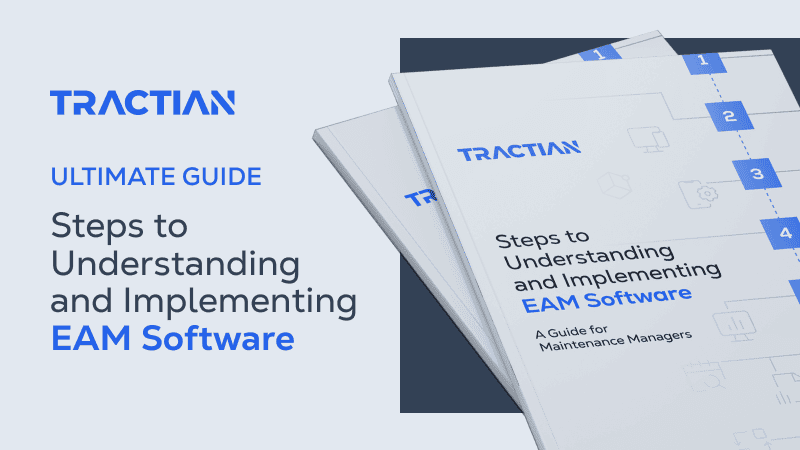When a control board fails mid-production and no spare is on hand, everything stops. There’s no repair, no quick fix, just overnight shipping, idle workers, and missed deliveries.
These failures don’t have to be unpredictable. With Mean Time to Failure (MTTF), maintenance teams can forecast when non-repairable components will reach end-of-life, schedule replacements proactively, and maintain the perfect balance between uptime and inventory costs.
This guide explains what MTTF really means, how to calculate it correctly, and how to use it to improve reliability, planning, and budgeting. You’ll also see how Tractian’s AI-powered CMMS automates MTTF tracking, turning a theoretical number into a real-time operational advantage.
What Is Mean Time to Failure (MTTF)?
Mean Time to Failure (MTTF) is the average operational time until a non-repairable component fails and must be replaced.
Think of components like bearings, circuit boards, sensors, and filters. Once they fail, there’s no repair process you discard and replace them.
MTTF focuses on one thing: the time until that final failure. It’s not about repair speed or downtime recovery; it’s about predicting when the component’s useful life will end so you can act in advance.
MTTF vs. MTBF vs. MTTR
- MTTF (Mean Time to Failure): For non-repairable items replaced after failure (sensors, bearings, circuit boards).
- MTBF (Mean Time Between Failures): For repairable equipment that can be fixed and reused (pumps, motors).
- MTTR (Mean Time to Repair): Measures how long it takes to restore a failed system to operation.
Each metric serves a different purpose. MTTF supports proactive replacement and inventory planning, while MTBF and MTTR guide reliability improvement and maintenance efficiency.
Why MTTF Matters for Maintenance and Reliability
When you lack visibility into component lifespan, two problems emerge: emergency downtime and wasted inventory.
Without MTTF data, you’re forced to choose between running until failure and risking costly unplanned downtime or replacing too early, wasting useful life and tying up capital.
MTTF eliminates that guesswork. By tracking the average lifespan of each component type, you can predict replacement needs, optimize stock levels, and plan maintenance activities long before failures disrupt production.
The Science Behind MTTF
Every component passes through three reliability phases:
- Infant mortality phase: Early failures caused by manufacturing defects or installation errors.
- Useful life phase: A stable period when failures occur randomly and the failure rate is constant.
- Wear-out phase: Aging components degrade, and failure rates increase rapidly.
MTTF applies only during the useful life phase, when the failure rate is statistically constant. It represents the mean of observed lifetimes across identical units, not a guarantee for a single component.
That’s why data consistency and sample size matter, tracking 50 identical sensors provides far more reliable results than tracking three.
How to Calculate Mean Time to Failure
The MTTF formula is simple:
MTTF = Total Operating Hours ÷ Number of Failures
The challenge is collecting accurate data.
1. Record Actual Runtime, Not Calendar Time
A sensor that operates 12 hours a day accumulates 4,380 hours per year, not 8,760. Always log real operational time through your CMMS or monitoring system.
2. Capture Failure Events Consistently
Define “failure” precisely. It’s when a component can no longer perform its intended function within design limits. Planned upgrades or preventive swaps don’t count.
3. Include Censored Data
Components still operating at the time of calculation contribute valuable runtime, even though they haven’t failed yet. This ensures your MTTF value isn’t underestimated.
MTTF (Mean Time to Failure) Example
A plant operates ten identical circuit boards. Four have failed; six are still running.
| Component | Hours Operated | Status |
|---|---|---|
| 1 | 12,500 | Running |
| 2 | 9,800 | Failed |
| 3 | 14,200 | Running |
| 4 | 11,300 | Failed |
| 5 | 13,600 | Running |
| 6 | 8,900 | Failed |
| 7 | 15,100 | Running |
| 8 | 10,700 | Failed |
| 9 | 14,800 | Running |
| 10 | 12,400 | Running |
Total operating hours: 123,300
Failures: 4
MTTF = 123,300 ÷ 4 = 30,825 hours
This number reflects the average lifespan of that component under current conditions. As more data accumulates, confidence in the value increases.
Turning MTTF Data Into Action
MTTF isn’t just a number, it’s the foundation for predictive maintenance, smarter inventory decisions, and better budgeting.
Smarter Inventory Planning
Knowing your components’ failure rates helps you maintain just the right amount of stock.
If a fleet of machines accumulates 120,000 operating hours per year and sensors fail every 8,000 hours on average, you can expect about 15 failures annually. With a two-week procurement lead time, maintaining one or two spare sensors on hand avoids emergency orders while keeping costs lean.
Proactive Replacement Scheduling
Replacing components at around 80% of their MTTF during planned downtime prevents most breakdowns without discarding usable parts. Over time, this approach cuts unplanned downtime and labor costs dramatically.
Budget and Forecasting Accuracy
Finance teams rely on predictable maintenance spending.
If you manage 200 control boards worth 800 dollars each and MTTF data shows an expected 64 annual failures, that’s $51,200 in annual replacement cost, a forecast you can plan around instead of guessing.
Vendor Evaluation and Warranty Validation
MTTF data exposes the real performance gap between manufacturers. If a supplier claims 50,000 hours but your data shows 30,000, you have proof for warranty claims and negotiations.
Procurement can compare not just prices, but total cost of ownership based on proven reliability.
How to Improve MTTF Over Time
Increasing your MTTF requires better reliability practices, not just better parts.
Component selection and design: Choose components rated for real-world loads, duty cycles, and environments. Oversizing within reason often increases lifespan without major cost impact.
Installation quality: Misalignment, poor grounding, and contamination lead to early failures that have nothing to do with part quality.
Condition monitoring: Vibration, temperature, and oil analysis help catch early degradation, extending effective lifespan beyond statistical averages.
When you combine MTTF insights with condition-based maintenance, you shift from reacting to failures to actively managing reliability.
The Organizational Impact of MTTF Visibility
When MTTF becomes a routine metric, its impact extends far beyond maintenance.
Plant managers can plan production with realistic uptime expectations. Maintenance managers can schedule resources proactively and minimize weekend callouts. Technicians know which components are nearing end-of-life and have the right spares waiting.
The entire operation becomes calmer, more predictable, and more cost-efficient. Instead of firefighting, teams execute planned work with confidence.
How Tractian Automates MTTF Tracking
Manual data collection is the single biggest barrier to accurate MTTF analysis. Technicians forget to log runtime, failure events go unrecorded, and spreadsheets quickly fall out of date.
Tractian’s AI-powered CMMS eliminates that problem entirely.
Once components are installed, Tractian automatically records runtime through integrations with PLC, SCADA, and machine sensors. When a component fails or is replaced, the system logs the event, operating hours, and failure mode automatically with no manual input required.
Real-Time Analysis and Alerts
As new data arrives, MTTF values update instantly. The platform’s dashboards and reports track confidence intervals so you know which components have reliable data and which need more observation.
When components approach their expected lifespan, Tractian sends proactive alerts to maintenance planners and generates replacement work orders with all required parts pre-loaded.
Connected Inventory and Workflows
Tractian ties MTTF directly to your spare parts and purchasing data. When inventory falls below expected consumption levels, it triggers purchase requests automatically preventing shortages before they happen.
Across multiple sites, Tractian aggregates identical component data to build fleet-wide MTTF models faster and more accurately than manual methods.
Combined with Tractian Condition Monitoring, the system detects early degradation like rising vibration or temperature before failures occur. This hybrid model catches both statistical and real-time anomalies, keeping your equipment reliability at its peak.
How to Start Using MTTF Today
Implementing MTTF tracking doesn’t have to be complicated. Start with three simple steps:
- Identify critical non-repairable components that cause major downtime or procurement costs.
- Begin runtime tracking through your CMMS or connected sensors, ensuring accurate data collection from day one.
- Log failures consistently and calculate your first MTTF baseline. Use that insight to schedule replacements proactively and optimize stock.
From there, expand across assets and sites. Within months, your organization will have enough data to make evidence-based decisions that permanently reduce downtime and cost variability.
With Tractian, all of this happens automatically, no spreadsheets, no manual entries, no uncertainty.
From Guesswork to Predictable Reliability
MTTF turns unpredictable component failures into a measurable, manageable process. By understanding how long non-repairable components last, maintenance teams can plan replacements in advance, balance inventory with precision, and keep production running without interruption.
With Tractian’s AI-driven CMMS, you don’t just calculate MTTF you act on it. Automated tracking, predictive alerts, and integrated inventory workflows ensure that you’re always one step ahead of the next failure.
Ready to make your maintenance program proactive and predictable?
Request a Tractian demo to see how AI-powered MTTF tracking can help your team prevent downtime before it happens.
Frequently Asked Questions About MTTF
What does MTTF mean in maintenance?
Mean Time to Failure (MTTF) measures the average operating time of a non-repairable component before it fails and must be replaced. It helps maintenance teams predict when items like bearings, sensors, or circuit boards will reach end-of-life so they can plan replacements and avoid unexpected downtime.
What is the difference between MTTF and MTBF?
MTTF applies to components that are replaced when they fail, such as sensors, electronic boards, and sealed bearings.
MTBF (Mean Time Between Failures) applies to repairable systems that can be fixed and returned to service, like pumps or motors.
In short, MTTF supports replacement planning, while MTBF supports reliability improvement and maintenance scheduling.
What type of assets use MTTF?
MTTF applies only to non-repairable assets, components that cannot be fixed after failure and must be replaced entirely.
Examples include:
- Electronic control boards
- Sensors and power supplies
- Sealed bearings and filters
- LED lighting, fuses, and certain hydraulic valves
Repairable systems use MTBF instead.
Why is MTTF important for maintenance teams?
MTTF gives teams the data they need to plan proactively. It reduces emergency breakdowns, optimizes spare parts inventory, and helps maintenance managers schedule replacements during planned downtime instead of reacting to failures.
It also supports budget forecasting, vendor comparisons, and capital planning, all based on real performance data rather than guesswork.
Can MTTF be used for predictive maintenance?
Yes. MTTF provides the statistical baseline for when components typically fail, while predictive maintenance adds real-time monitoring to detect anomalies before that point.
Tractian combines both approaches using condition monitoring to identify early signs of degradation and MTTF data to schedule replacements with precision.
What is a good MTTF value?
There’s no universal number, a “good” MTTF depends on the asset type, environment, and operating conditions.
The key is consistency and improvement. As you collect more data, your MTTF baseline becomes more accurate, allowing you to benchmark performance across locations and identify which vendors or conditions yield longer lifespans.
What is the relationship between MTTF and equipment reliability?
MTTF is one of the core reliability metrics used in maintenance management. Higher MTTF values indicate components last longer between failures, which directly improves Overall Equipment Effectiveness (OEE) and reduces total maintenance cost.
When integrated into an AI-powered CMMS like Tractian, MTTF transforms from a theoretical concept into a real-time decision tool that drives measurable reliability gains.


